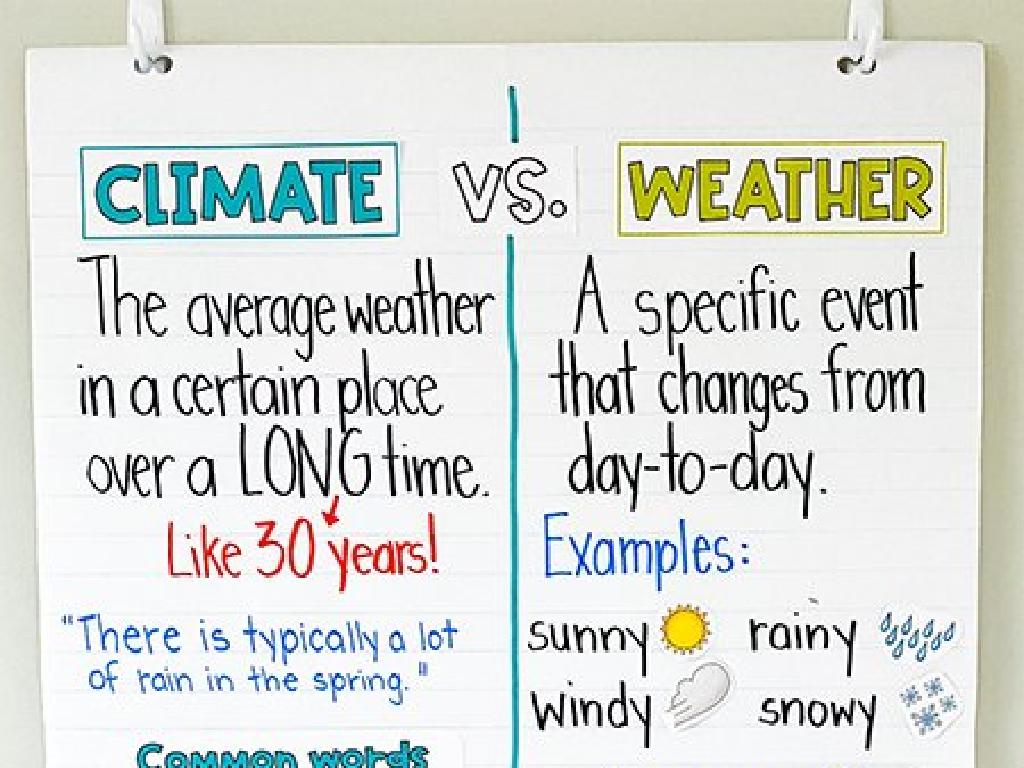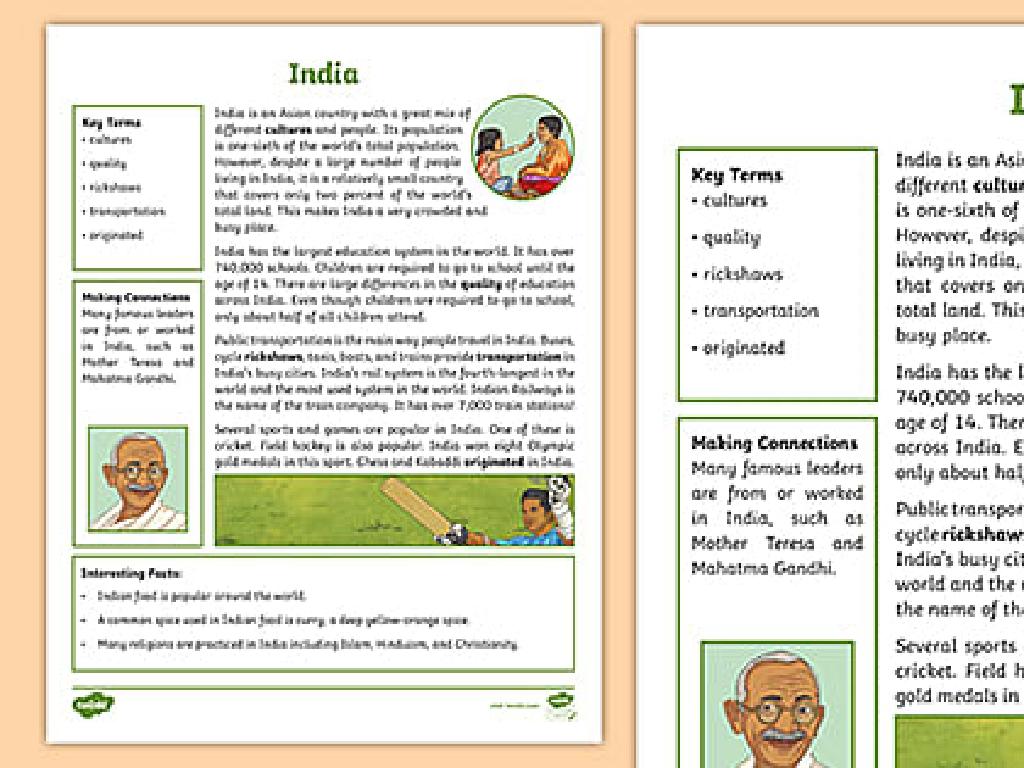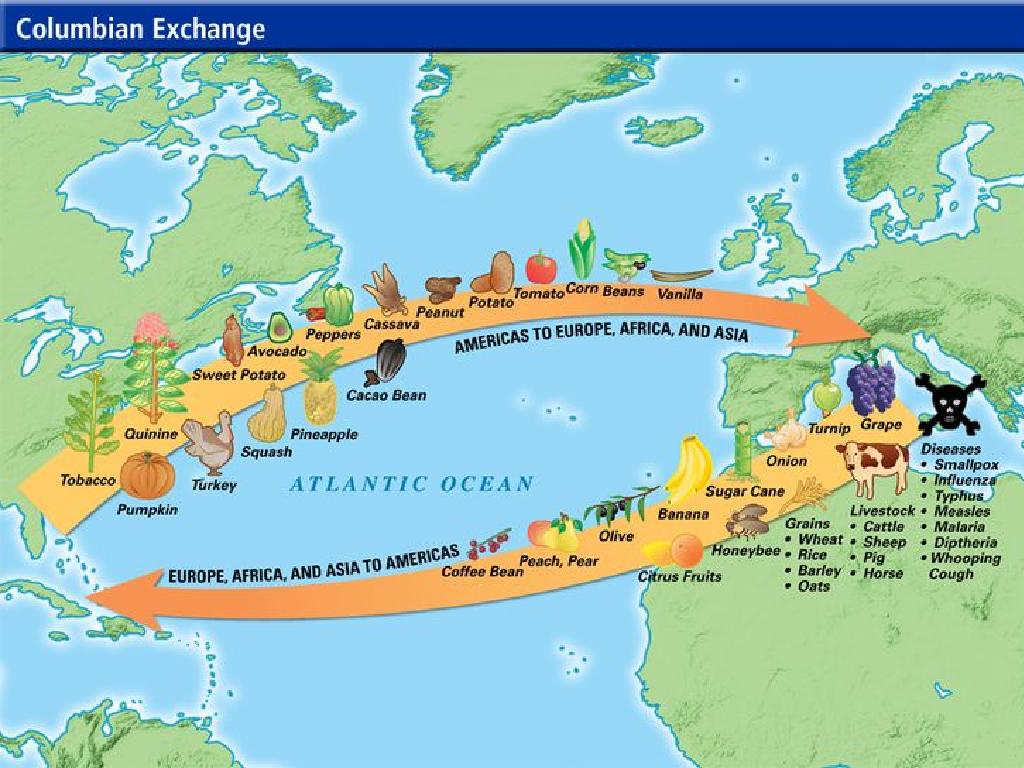Identify Countries Of Africa: Review
Subject: Social studies
Grade: Sixth grade
Topic: Africa: Geography
Please LOG IN to download the presentation. Access is available to registered users only.
View More Content
Exploring the Countries of Africa
– Introduction to Africa’s geography
– Africa is the second-largest continent with over 50 countries.
– Diversity and beauty of Africa
– From deserts to rainforests, Africa’s landscapes are diverse.
– Identifying African countries
– Learn to locate countries like Egypt, Nigeria, and Kenya.
– Map recognition skills
– Use a map to find and name various African countries.
|
This slide is aimed at familiarizing students with the geography of Africa, emphasizing its size, diversity, and the number of countries it encompasses. Highlight the variety of landscapes found across the continent, from the Sahara Desert to the tropical rainforests of the Congo. Encourage students to recognize and identify key countries on the map, such as Egypt in the north, Nigeria in the west, Kenya in the east, and South Africa in the south. Provide a map for students to practice their skills in identifying and naming the countries, reinforcing their geographical knowledge through visual aids. This activity will help students appreciate the continent’s diversity and improve their map-reading skills.
Exploring the Continent of Africa
– Africa: the second-largest continent
– Home to 54 diverse countries
– Each country has distinct culture and history
– Discover geographical facts
– Learn about deserts, rivers, and mountains
– Embrace Africa’s uniqueness
– Understanding the diversity is key to geography
|
This slide aims to provide an overview of Africa’s geographical significance and cultural diversity. Emphasize that Africa is only second to Asia in size, which contributes to its vast diversity in terms of geography, culture, and history. Highlight that the continent comprises 54 countries, each with its own set of traditions and historical backgrounds. Introduce students to some of Africa’s prominent geographical features, such as the Sahara Desert, the Nile River, and Mount Kilimanjaro. Encourage students to appreciate the uniqueness of each African country and how geography has shaped their individual cultures. This will set the stage for a more in-depth review of individual countries in subsequent lessons.
Exploring Northern Africa
– Countries in Northern Africa
– Examples: Egypt, Libya, Morocco
– The Sahara Desert
– The Sahara is the world’s largest hot desert
– The Nile River
– Can you find the Nile River on a map?
– Map locating activity
|
This slide aims to review the countries of Northern Africa and highlight significant geographical features such as the Sahara Desert and the Nile River. Start by discussing the countries in the region, focusing on Egypt, Libya, and Morocco. Explain the vastness of the Sahara Desert and its impact on the climate and culture of the region. Then, engage students with a map activity to locate the Nile River, emphasizing its importance in the history and economy of the countries it flows through. This interactive approach helps students connect with the material and reinforces their understanding of Africa’s geography.
Exploring Western Africa
– Countries in Western Africa
– Nigeria, Ghana, Senegal among others
– Historical kingdoms and trade
– Rich past with powerful kingdoms like Mali and Songhai, known for trade
– Diverse climates of the region
– From humid coastlines to dry, inland savannas
– Coastal vs inland areas
|
This slide aims to give students a brief overview of Western Africa, highlighting its geography and historical significance. Students should be able to identify key countries in this region, such as Nigeria, Ghana, and Senegal. Discuss the historical context of the area, focusing on the rich heritage of kingdoms like Mali and Songhai, which were centers of trade and culture. Explain the climatic diversity, emphasizing the differences between the humid, tropical coastlines and the drier inland savannas. Encourage students to explore how geography has influenced the region’s history, culture, and development. Use maps to help students visualize the location of countries and their landscapes.
Exploring Central Africa
– Discover the Congo Basin
– Second-largest rainforest in the world, vital for biodiversity.
– Countries in Central Africa
– Includes nations like the Democratic Republic of the Congo and Cameroon.
– Natural resources abundance
– Rich in diamonds, oil, and other valuable materials.
– Significance of resources
– These resources impact the economy and global markets.
|
This slide aims to review the key characteristics of Central Africa, focusing on its geography, countries, and natural resources. The Congo Basin is highlighted for its ecological importance as the second-largest rainforest, which plays a crucial role in supporting global biodiversity. Students should recognize countries such as the Democratic Republic of the Congo and Cameroon as part of this region. Emphasize Central Africa’s wealth in natural resources, including diamonds and oil, which are significant for the countries’ economies and have a broader impact on international trade and industry. Encourage students to think about how these resources can affect both local and global communities.
Exploring Eastern Africa
– Countries: Kenya, Ethiopia, Tanzania
– Explore the geography and culture of these nations
– Known for Great Rift Valley
– A geographical wonder stretching 6,000 km
– Abundant wildlife habitats
– Safaris: See lions, elephants, and giraffes in their natural environment
– Home to Mount Kilimanjaro
– Africa’s highest peak, a climber’s paradise
|
This slide aims to review the key features of Eastern Africa. Highlight the diverse countries within this region, such as Kenya, Ethiopia, and Tanzania, each with its unique geography and culture. Discuss the Great Rift Valley, a significant geological feature that offers insight into continental drift. Emphasize the region’s rich biodiversity, making it a prime location for wildlife safaris. Lastly, touch upon Mount Kilimanjaro in Tanzania, a symbol of Africa’s varied landscapes and a challenge for mountaineers. Encourage students to research more about the wildlife and how the geography of Eastern Africa affects the climate and living conditions.
Exploring Southern Africa
– Countries in Southern Africa
– Includes South Africa, Botswana, Zimbabwe, etc.
– Diverse ecosystems
– Features savannas, deserts, and more
– The Cape of Good Hope
– A famous landmark located at the southern tip
|
This slide aims to review the countries in the Southern Africa region and highlight its unique geographical features. Students should be able to identify key countries such as South Africa, Botswana, and Zimbabwe on a map. Discuss the variety of ecosystems found in this area, from savannas, which are grassy plains, to the Kalahari Desert. Emphasize the significance of the Cape of Good Hope as a historical point of navigation and a tourist attraction. Encourage students to explore the different climates and natural environments that exist within Southern Africa and how these affect the lifestyle and culture of the people living there.
Island Nations of Africa
– Madagascar: Earth’s fourth largest island
– Known for unique species like lemurs and baobabs
– Mauritius & Seychelles: Unique biodiversity
– Home to rare animals and plants, some endangered
– Island nations’ role in Africa’s geography
– Conservation of unique ecosystems
– Efforts to protect their rare environmental heritage
|
When discussing the geography of Africa, it’s crucial to include the island nations, which are often overlooked. Madagascar, the fourth largest island in the world, is renowned for its unique wildlife, such as lemurs and baobab trees. Mauritius and Seychelles also boast unique flora and fauna, with many species that are not found anywhere else on the planet. Emphasize the importance of these islands to Africa’s geographical identity and the need for conservation efforts to protect their unique ecosystems. Encourage students to explore the reasons why these islands have such unique biodiversity and discuss the global significance of their conservation.
Class Activity: Mapping Africa
– Identify African countries on a map
– Label countries using the blank maps
– Pair up for collaborative learning
– Work together to find and label each country
– Discuss each country’s characteristics
– Share facts or features you know about the countries
|
This activity is designed to reinforce the students’ knowledge of African geography by identifying and labeling the countries on a map. Provide each pair with a blank map of Africa and a list of countries to ensure they have the resources needed to complete the task. Encourage collaboration and discussion among students to facilitate peer learning. As they work, they should also share any interesting facts or features they know about each country, integrating knowledge from previous lessons. This will help them to not only memorize the countries but also understand the diverse cultural and geographical aspects of the continent. After the activity, have a group discussion to review and fill in any gaps in their maps.
Review: Countries of Africa and Their Influence
– Recap of African countries
– Share an interesting fact
– Did you learn about Egypt’s pyramids or Kenya’s wildlife?
– Geography’s impact on culture
– Consider how deserts, rainforests, and mountains shape lives.
– Daily life varies by region
– How might living near the Nile differ from the Sahara?
|
This slide aims to consolidate the students’ knowledge of African countries and understand the continent’s diverse geography. Encourage students to reflect on the countries they’ve learned about by sharing an interesting fact or something new they discovered. Discuss how Africa’s varied geography, including its deserts, rainforests, and mountains, influences the culture and daily life of its people. For example, the availability of water in Egypt’s Nile River Valley supports agriculture, while the Sahara’s harsh conditions lead to a nomadic lifestyle. This reflection will help students appreciate the connection between geography and human activity and recognize the diversity within the African continent.





